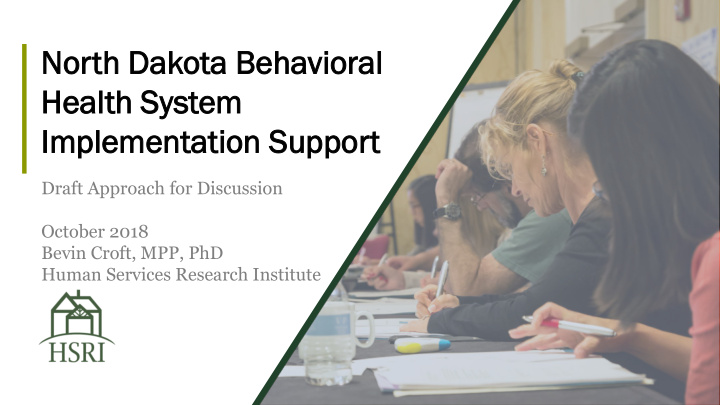



No North th Da Dakota ta Beha ehavioral vioral He Health alth Sy Syst stem m Implement plementation ation Sup uppor port Draft Approach for Discussion October 2018 Bevin Croft, MPP, PhD Human Services Research Institute
Invest in prevention and early intervention Ensure timely access to behavioral health services Expand outpatient and community-based services Enhance and streamline system of care for children and youth The HSRI recommendations were based on our analysis, Continue criminal justice strategy principles of good and modern behavioral health Recruit and retain a competent workforce systems, and the Expand telebehavioral health community’s vision for system change Ensure values of person-centeredness, cultural competence, and trauma-responsiveness Encourage and support community involvement Partner with tribal nations to increase health equity Diversify and enhance funding
The “bookend” recommendations from our 2018 analysis were created to support infrastructure for effective and ongoing system transformation Reconvene system stakeholders 1: Develop a comprehensive Form an oversight steering committee implementation plan Establish work groups Integrate data systems 13: Conduct ongoing, system-wide, data- Develop system metrics driven monitoring of needs and access Identify and target services to those with highest service costs
Our approach Support coordinated, data-driven system improvement activities through the implementation of the recommendations from the Behavioral Health System Study , with a focus on the first and last (“bookend”) recommendations Set the course for the community to engage in ongoing system monitoring, planning, and improvements in the long-term
Sample View of the Current System School Districts Local Health Systems Tribal Nations Child Welfare System Housing Authorities Free Criminal Justice and Law Enforcement Social Service Agencies Public Health through Recovery Children’s Behavioral Behavioral Health Health Workforce Behavioral Health Task Force Work Group Planning Council Medicaid Tribal Dual Consultation Status Group Youth Initiative ND Rural Health ND Brain Learning Injury Collaborative Network Team Community Providers Peer and Family Advocacy Department of Human Services
Proposed Roles and Functions School Districts Local Health Systems Tribal Nations Child Welfare System Housing Authorities Physical/ Free Criminal Justice and Law Enforcement Social Service Agencies Public Health BH through Integration Recovery Children’s Behavioral Work Behavioral Health Group Health Workforce Behavioral Health Task Force Work Group Planning Council Medicaid Tribal Implementation Dual Consultation Status Facilitation Group Youth Initiative ND Rural Health ND Brain Learning Injury 1915(i) Collaborative Network Prevention Work Team Work Group Group Community Providers Peer and Family Advocacy Department of Human Services
1. Strategic Planning • Finalize purpose, scope, and roles • Operationalize goals (goal matrix) • Develop strategic plan protocol Four 2. Prioritization & 4. Monitoring & Sustaining Phases of Refinement • Monitor ongoing progress • Specify objectives, action steps, • Troubleshoot issues Work and indicators of progress • Initiate additional goals as • Establish priority and timeline needed • Determine responsibilities 3. Initiation • Gather baseline data on each goal and objective • Work with stakeholders to initiate action
Goal Matrix Template HSRI Report Primary Relevant Required Priority Status Recommen- Entities Work Groups Policy, dation Regulatory, or Legislative Actions After ratifying the initial goal matrix in Phase 1, we will develop a final strategic plan in Phase 2. It will include SMART goals, specific tasks, roles and responsibilities, priority/timeline, and indicators of progress/success that will be benchmarked during Phase 3 (Initiation)
• Articulation of roles (e.g. HSRI, state and local entities, BH Planning Council and other work groups) Strategic Plan • Strategy for ensuring ongoing alignment with existing initiatives Protocol • Processes for group coordination and communication • Processes for ensuring meaningful and ongoing stakeholder engagement
Timeline and Deliverables 1. Strategic 2. Prioritization 3. Initiation 4. Monitoring & Planning & Refinement Sustaining • March 2019 progress report • Draft strategic plan • Final strategic plan • Revised/amended protocol (protocol, goals & strategic plan objectives) • Ratified goal • June 2019 progress matrix report Nov. – Dec. Jan. – Mar. Apr. – June Oct. 2018 2018 2019 2019
Th Thank nk You ou. Bevin Croft bcroft@hsri.org 617-844-2536
Recommend
More recommend